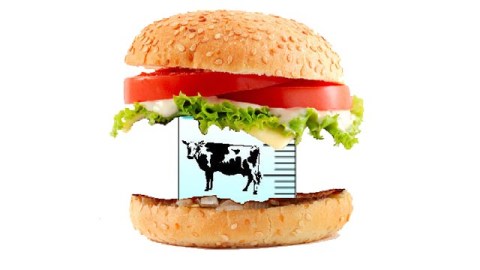Frankenmeat: Growing a Burger in a Petri Dish

Using human stem cells to tackle human health issues remains controversial in the United States, but a team of Dutch researchers has found a potentially crowd-pleasing application of stem cell technology: growing a hamburger in a Petri dish. The full burger isn’t ready for the grill just yet, but the long-term consequences for the environment and human eating habits could be enormous.
According to an article in the Guardian, the researchers, led by Dr. Mark Post, have thus far “grown thin sheets of cow muscle measuring 3cm long, 1.5cm wide, and half a millimetre thick.” To go from this to a full burger the scientists will “take 3,000 pieces of muscle and a few hundred pieces of fatty tissue, that will be minced together and pressed into a patty.”
Is your stomach rumbling yet? Dr. Post acknowledges that the eating experience of the so-called Frankenburger might not approximate that of an honest-to-goodness chopped up cow, but insists that the technological process could be revolutionary. While the current procedure is estimated to cost about $317,000, the scientific hurdles have been cleared and the operation could scale up to reduce costs.
But what’s the advantage? The Worldwatch Institute reports that “livestock and their byproducts actually account for at least 32.6 billion tons of carbon dioxide per year, or 51 percent of annual worldwide GHG emissions.” That’s more greenhouse gases than are created by all transportation, even though cars generally soak up the public blame for pollution. With this statistic in mind, producing meat in a lab seems like a promising alternative to using up precious farmland and grain to feed massive herds of livestock, especially given that worldwide demand for meat is expected to skyrocket as the economies of China, India, and other developing nations continue to make strides.
This is the Floating University, though, so let’s get into the nitty gritty science of how to grow a hamburger in a test tube. According to the Guardian article,
Each piece of muscle is made by extracting stem cells from cow muscle tissue and growing them in containers in the laboratory. The cells are grown in a culture medium containing foetal calf serum, which contains scores of nutrients the cells need to grow.
The slivers of muscle grow between pieces of Velcro and flex and contract as they develop. To make more protein in the cells – and so improve the texture of the tissue – the scientists shock them with an electric current.
This makes the Frankeburger seem even more freakish, but the science and potential behind stem cells are staggering. To get a rough understanding of how scientists can take a cow’s stem cells and turn them into a main course, check out this clip from Douglas Melton’s FU lecture about Biomedicine, in which he explains how human stem cells can be grown into a human heart:
That’s the basic underlying principle of stem cell science, and the applications are almost unlimited. Supporters of the Frankenburger claim that lab-grown meat will allow vegetarians to bypass moral objections to the killing of animals. But this line of thinking can go much further, as the pioneer of the Frankenburger attests: “We could make panda meat, I’m sure we could.”
If any kind of animal meat could be grown in a lab, does that make it okay to eat? Taking it further, would it be permissible to eat human meat that was grown in an identical fashion to the Frankenburger or Pandaburger? Is this a slippery slope to amoral gastronomy powered by advanced science? How does this tie into the broader debate about using stem cells to grow organs for humans?
Visit The Floating University to learn more about our approach to disrupting higher education, or check out Douglas Melton’s eSeminar “What’s Up, Doc? Is Biomedical Research Really Close to Curing Anything?”
Image courtesy Flickr user Mike Licht





